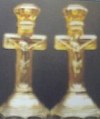Carnival Glass 101 | home Quick Reference to Carnival Glass Patterns on This Site
Controversial Imperial Patterns - Part 1
"Controversial” IMPERIAL Patterns - Part 1
One might say that we have “come a long way” since the days of some mis-attribution by Minnie Watson Kamm in her early series of pattern glass books, written way back in the 1940s, but she must be given credit for “getting the research ball rolling”. She established a frontier of learning, from which we have all come to benefit. Errors continue to erupt from time to time, no matter the writer or subject matter.
There is nothing quite like a discussion surrounding Carnival Glass and the various pattern names which have evolved over the years since Marion Hartung and Rose Presznick took their turns with “the subject”. We'll not delve into the differences experienced / expressed by those two writers / researchers between 1962-1975. Suffice it to say: They disagreed in many instances surrounding their conclusions!
The Fifth Book in Hartung Series, c. 1975-page 40 displays a drawing of the Heavy Diamond open sugar, noting its derivation “in the field of clear glass.” She makes no reference to the Imperial #330 line dating from the 1920s. Page 53 of the same book displays a drawing of a Diamond Block salt (or pepper shaker), noting it stands 4 ½” tall with a base diameter of 2 3/8”. She mentions a large open flower and the figure “5” impressed into the base. She attributes the design as such: U.S. Diamond Block.
Sherman Hand, aided by Charlotte Williams, placed their written contribution into the 1972 timeframe. “Diamond Star” came into play as Hand's name for Mount Vernon, the original factory catalog name for #699 as it was known in non-iridized crystal.
As today's collectors realize, each pattern assumes an appropriate carnival glass name. The pattern name, Diamond Star never caught on with the dozens of collectors we have known on both the West and the East Coasts of the United States, for during our more than 40 active years associated with carnival glass, we have never heard it used with regard to “Diamond Block”. S. Hand displays the Diamond Block cylindrical vase in his Book 4-page 95.
During the years of Don Moore research / writing, disclaimers of some previous determinations were evident. Many previous conclusions were no longer taken for fact.
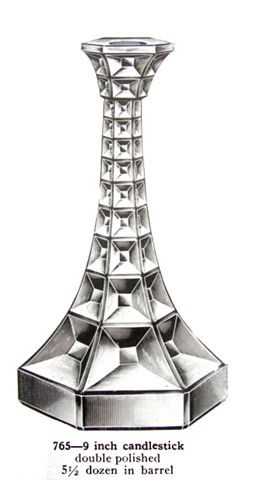
# 765 - Page 62A - Imperial Catalog 104A.
In 1978, Margaret and Douglas Archer produced a book on Imperial glass, devoting pages 153-154 to the Mount Vernon crystal pattern. Possibly for the sake of limited page space, they individually applied the 13 elements on page 153 (noting they are ¼ catalog size). Perhaps they thought candlestick #765 “resembled” Mount Vernon and placed it among the other examples? However, it is our belief that #765 stands alone on the catalog page noted under the photo shown in this segment and actually does not belong in the Mount Vernon grouping.
Jane Dinkins, c.1995 wrote about and displayed the cylindrical vase in an ICGA Pump article, referring to it as “Mount Vernon” or “Diamond Star”. She obviously was following previous written statements.
*Confusion reigns! Vol. II, page 352 of the Imperial Glass Collectors trio of books, states:
“HEAVY DIAMOND - is the name Carnival Glass collectors use in referring to #330 line. Weatherman calls #330 DIAMOND BLOCK, and Carnival Glass collectors compound the confusion by calling Imperial's # 699 DIAMOND BLOCK. Imperial's #330 line dates from the late 1920s.”
A finite detail which creates error in names attributed to carnival glass patterns: Former names applied to a previous crystal glass line should not be adhered to when discussing the later iridized counterparts-at least when discussing American-made glass.
Some previous writers to this point in time, did not submit to a change in identifying names!
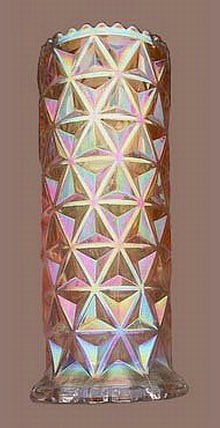 |
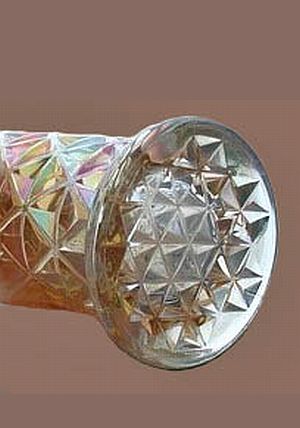 |
DIAMOND BLOCK
10 in. Vase,
4 in. top opening.# 699.
|
DIAMOND BLOCK Base-
4.25 in. diam.# 699.
|
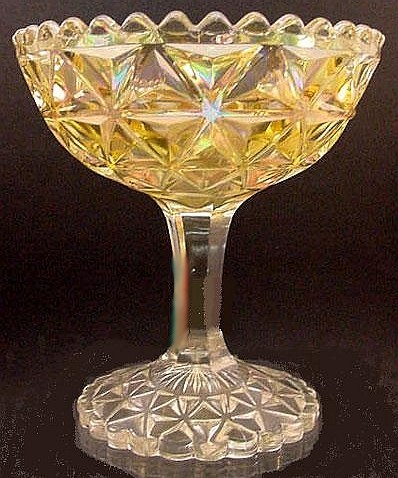 |
|
DIAMOND BLOCK Compote in Clambroth - 5 in. tall. # 699.
|
|
Diamond Block (#699) is defined by large diamonds which recede inward.
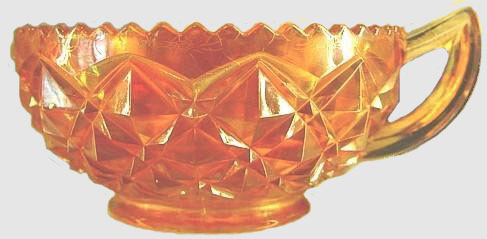 |
|
HEAVY DIAMOND - # 330 5 in. nappy
|
|
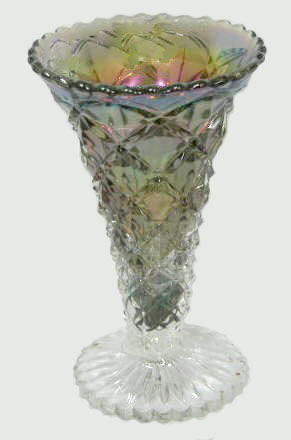 |
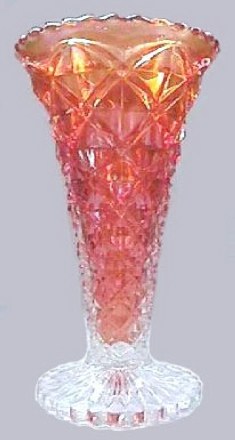 |
HEAVY DIAMOND # 330
- Smoke.
|
|
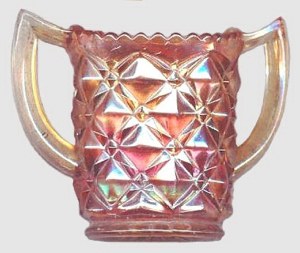 |
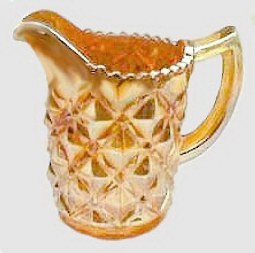 |
HEAVY DIAMOND Sugar-3 in.
tall with a 3 in. opening.- # 330.
|
HEAVY DIAMOND
Creamer-# 330.
|
Heavy Diamond (#330) is defined by a double line around the protruding diamond shapes.
This brings us to 1996 and Carl O. Burns' Imperial Carnival Glass book. His reference to DIAMOND BLOCK as the original Imperial #699 pattern does not include mention of the lamp shade. However, a marigold lamp shade is listed in the Price Guide section.
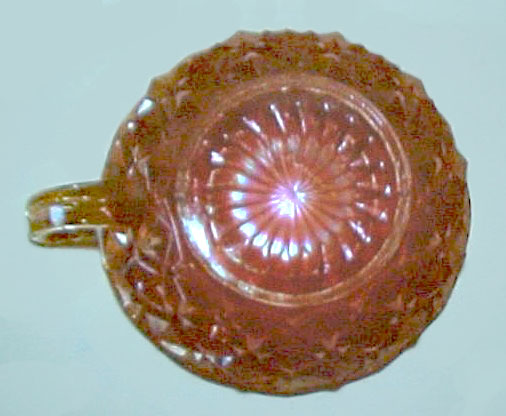
20-point Star Design on base of HEAVY DIAMOND Nappy.
Courtesy Roy Hieger
Noted collector / researcher / writer, Roy Hieger of Texas has contributed photos and text to be included in our Controversial IMPERIAL Patterns - Part 2. Roy has also supplied the above photo of the Heavy Diamond Nappy base, displaying a 20 point star. This handsome feature accompanies the carry-over shapes from crystal / cut glass into the earliest of carnival glass example, including the open sugar / creamer. As new moulds were produced specifically for carnival glass, the marie areas were left plain, presumably to restrict mould costs.
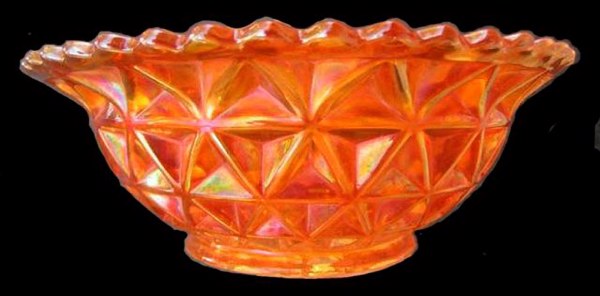 |
|
DIAMOND BLOCK Bowl in Mgld.- #699.
|
|
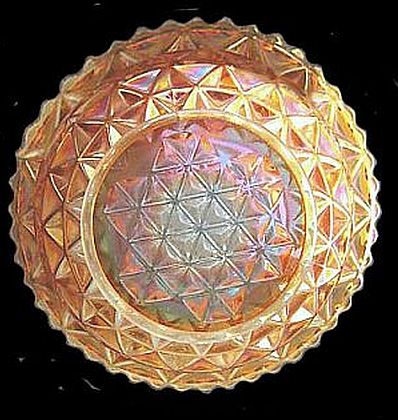 |
|
DIAMOND BLOCK Bowl-8.5 in. diam. x 3.5 in. deep.
Courtesy Rocky Van Natta.
|
An 8 ½”x 3 1/2” Diamond Block marigold bowl is the latest addition to the list of shapes. Rocky Van Natta found the bowl and sold it over eBay for $25! (Another “rare-so-what!”) For pattern collectors, it's exciting to be able to own an example in such scarce diamond designs as these.
Candlesticks 9”, marigold, clambroth; Compote-marigold, clambroth; Milk pitcher-marigold, clambroth; Rose bowl-marigold, clambroth; Tumbler-juice size-marigold, clambroth, Vase-cylindrical, 12”-marigold; Vase-pedestal-footed, 8”-9”, marigold, clambroth, smoke are the other shapes mentioned in Carl Burns book.
HEAVY DIAMOND is defined by the pedestal-footed vase. Imperial produced more of that type vase than any other manufacturer and this shape appears more often than the others: Bowl-10”, marigold; Compote-marigold, green; Creamer and sugar-marigold; Vase-pedestal footed, marigold, green, clambroth, smoke.
Our segment: Imperial Glass - Part 1, written and posted on our www.carnivalglass101.com site in 2004, does not follow Carl's research. One of the Blessings in writing for a site, rather than book print, is the ability to change an opinion and re-state a case founded on corrected research. Re-thinking, re-working and re-stating research keeps our minds active so as not to assume an outdated mind-set! Viewers will find those same three Heavy Diamond objects included in this segment, along with an updated conclusion.
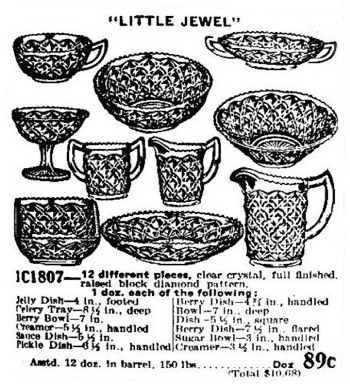 |
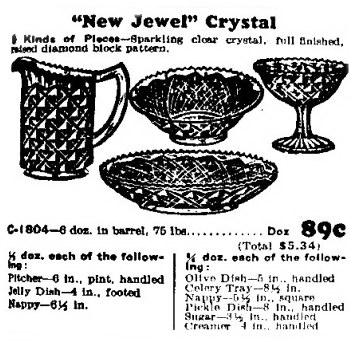 |
LITTLE JEWEL - Mid-Winter 1927 + Apr.1929 Butler Bros. Catalog.
|
NEW JEWEL -
Apr.1931 Butler Bros. Catalog.
|
LITTLE JEWEL seen in the Imperial Catalog ad, displays the shapes Carnival Glass collectors recognize as Heavy Diamond, as well as the designs of NEW JEWEL, re-introduced in 1931. It must have been a good seller in crystal, but few examples are found iridized. Literally hundreds of various patterns pass through the auction process each year, without an example in either of these Imperial Diamond designs.
Our hope is that with this effort to place some emphasis on these two (largely overlooked) carnival glass patterns, heightened interest in the search will ensue? Diamond Block and Heavy Diamond extend a far more rare opportunity than many of the “pricier-well-known” rarities!
Dean / Diane Fry - 9/09
A Final Footnote to Add to the Confusion -- or My Two Cents by Donna Adler
A name is a name is a name unless you are talking about the Mt Vernon pattern. Almost EVERY glass company and china manufacturer had a Mt Vernon pattern. It is by far a VERY overused name. Among the glass companies who had a Mt Vernon pattern are:
Even Avon Sold a Mt Vernon pattern.
The "Diamonds" in the above Mt Vernon patterns are much smaller than the Imperial Diamond Block and Heavy Diamond patterns. Please do not refer to these patterns as Mt Vernon. It would add to an already too confusing pattern name.
Donna Adler 8/09


But when the Pharisees heard that He had silenced the Sadducees, they gathered together.
Then one of them, a lawyer, asked Him a question, testing Him, and saying ,”Teacher, which is the great commandment in the law?”Jesus said to him `You shall love the Lord your God with all your heart, with all your soul, and with all your mind.' This is the first and great commandment. And the second is like it: `You shall love your neighbor as yourself.' On these two commandments hang all the Law and the Prophets.” ~~~ (Matthew 22:34-40)
The Sadducees were members of a Jewish sect, which probably dominated the Sanhedrin
~~~ (Acts 175:17)


Should you care to contact the Frys, their email address is:
Search Carnival Glass 101
back to Carnival Glass 101
Our other sites you may enjoy:
Everything you EVER wanted to know about Indiana Glass
Great Reference for Newer Carnival Glass.
Complete Glassware Catalogs Available to Download
Questions? Comments? Suggestions? Broken Links? Corrections?
Your Friendly Webmaster is here to help!
